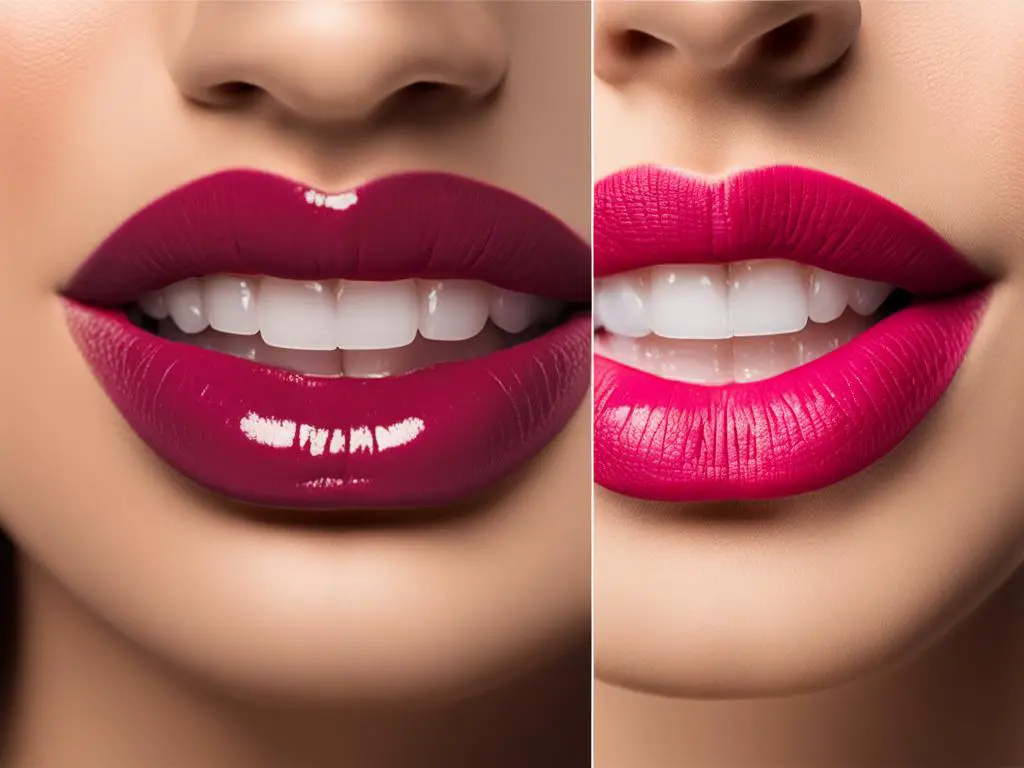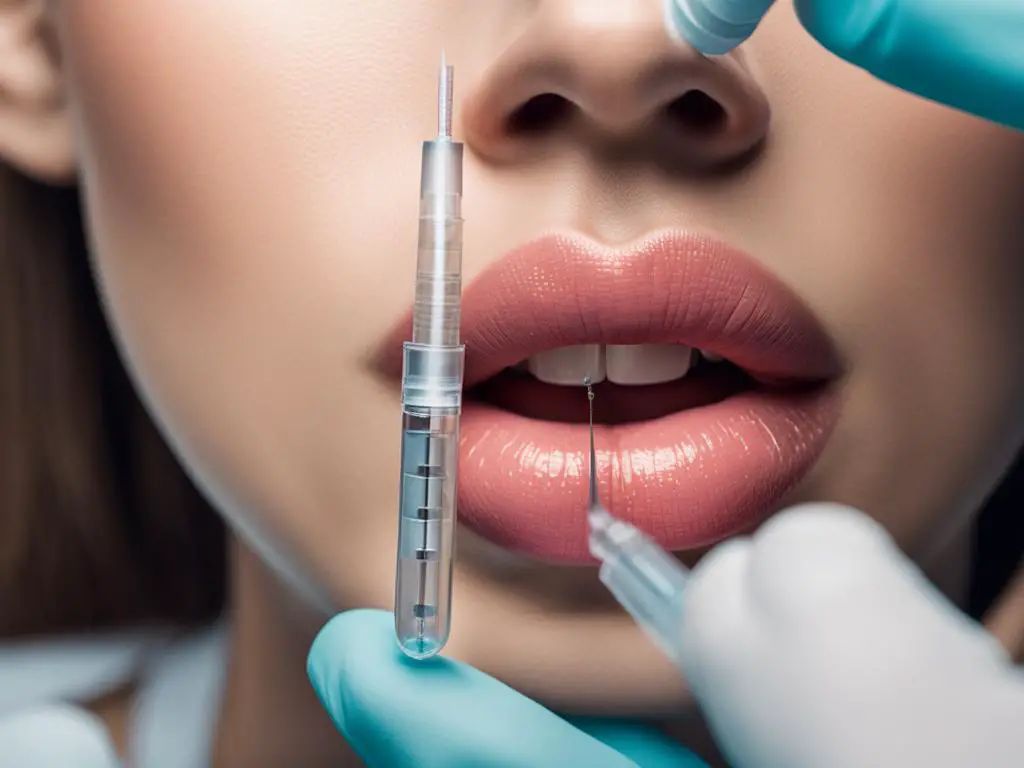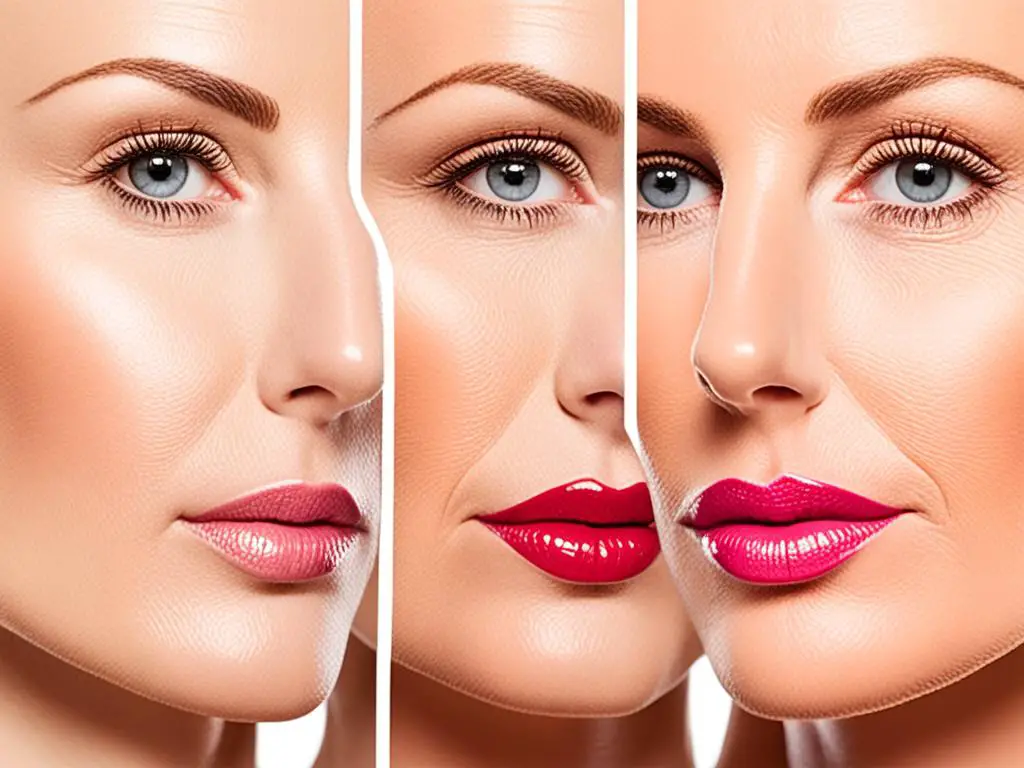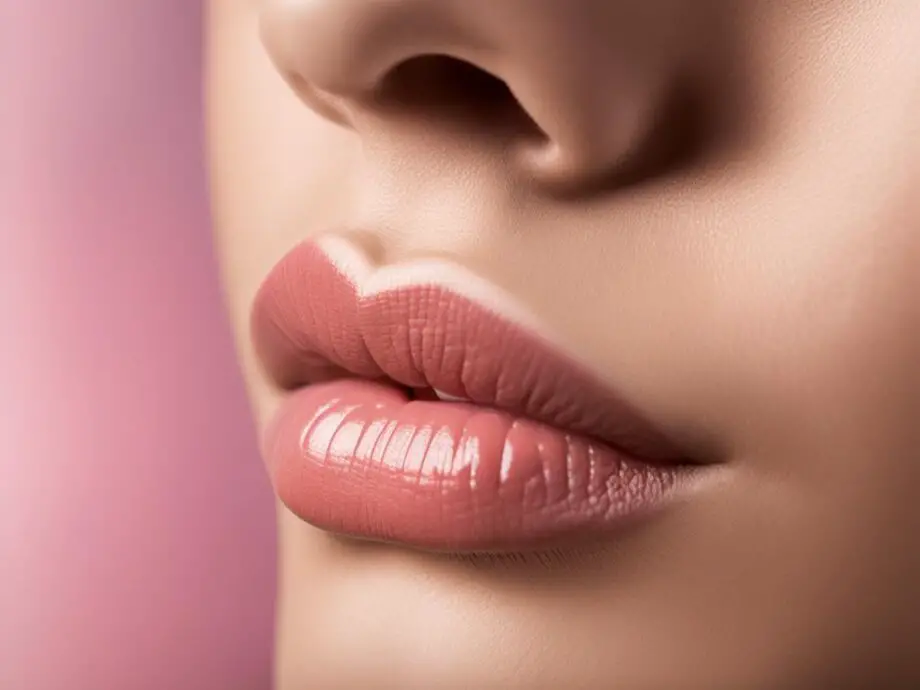Full, luscious lips have become increasingly popular in recent years, prompting many individuals to explore cosmetic options for enhancing their lips. Lip fat transfer and fillers are two popular choices for those seeking a natural-looking enhancement. While both procedures have their benefits and drawbacks, it’s essential to consider individual preferences and desired results before making a decision.
Key Takeaways:
- Lip fat transfer and fillers are popular choices for natural lip enhancement.
- Individual preferences and desired results should dictate the chosen procedure.
- Both procedures have their benefits and drawbacks.
- Important factors to consider include cost, invasiveness, and longevity of results.
- Choosing a qualified and experienced practitioner is crucial for minimizing risks and achieving the desired outcome.
Understanding Lip Fat Transfer
If you’re looking for a natural way to enhance your lips, lip fat transfer is a procedure worth considering. Essentially, it involves taking fat from other parts of your body and injecting it into your lips to plump them up. Here’s a closer look at how this fat transfer procedure can give you natural-looking lip augmentation and facial rejuvenation.
How Lip Fat Transfer Works
The first step in lip fat transfer is to choose an area of your body for the fat extraction. Commonly these areas include the abdomen, hips, or thighs. This fat is then processed and injected into your lips through a series of injections.
The fat transfer procedure is done carefully and precisely, with special attention given to ensuring that it is evenly distributed for a balanced enhancement. The result is a natural-looking augmentation that can last for years.
The Benefits of Lip Fat Transfer
One of the main benefits of fat transfer is that it uses your body’s own fat, which makes it a natural option with little to no risk of allergic reactions. And because the fat is coming from your own body, the results are generally very long-lasting. In addition, lip fat transfer can rejuvenate the appearance of your face, giving you a more youthful look.

Potential Drawbacks of Lip Fat Transfer
While lip fat transfer is a safe and natural procedure, there are some potential drawbacks to consider. One of these is the fact that liposuction is required to extract the fat. As such, there may be some discomfort, bruising, and swelling in the areas where fat was removed, but these typically fade within a few weeks.
“Lip fat transfer is the best way to achieve a natural-looking lip enhancement. The results are amazing and last forever!” – Kate, 33
The Power of Fillers
For those seeking a non-invasive solution to lip augmentation, fillers may be the answer. Lip fillers are a popular cosmetic lip procedure that can enhance lips’ fullness and shape without downtime or surgery. By injecting hyaluronic acid or collagen gel into the lips, the product gently plumps them, leaving a natural-looking, luscious pout.
What makes lip fillers an attractive option is their immediate results, which typically last for six to eight months. Additionally, the procedure is relatively affordable compared to other cosmetic lip procedures, making it an accessible option for many people.
With varying types of fillers available, it is essential to work with a qualified provider to determine which option aligns with individual goals and expectations. Some brands specialize in a more natural look, while others extend to those who want a more dramatic appearance.
Although fillers are deemed safe for most people, some risks and side effects may arise, including bruising, swelling, and allergic reactions. Therefore, it’s always in one’s best interest to consult with a medical professional to discuss any risks or concerns.

“I’m thrilled with my lip fillers’ results. My lips are more full and natural-looking without having to undergo a surgical procedure. It was an easy and relatively painless experience, and I would recommend it to anyone looking for a quick fix for their lips.” – Margaret, 29
Choosing the Right Option
Deciding between lip fat transfer and fillers depends on several factors, including individual preferences, desired results, and budget. While lip fat transfer is a natural and long-lasting option, the initial cost is higher due to the need for a separate liposuction procedure. On the other hand, fillers are a non-invasive and relatively affordable alternative but may require touch-up injections to maintain the desired look.
When considering lip augmentation, it’s essential to consult with a qualified practitioner and discuss the benefits and risks of both procedures. While lip fat transfer and fillers are generally safe and effective, some individuals may not be suitable candidates due to medical conditions or allergies. Therefore, it’s crucial to have realistic expectations and understand the potential outcomes of each option.
Ultimately, the best choice for natural lip enhancement depends on each person’s unique circumstances and facial features. Patients should work closely with their doctor to determine the optimal procedure that delivers the desired results and ensures a luscious smile.

Comparative Table
| Criteria | Lip Fat Transfer | Fillers |
|---|---|---|
| Procedure Type | Invasive – requires liposuction | Non-invasive – injection |
| Downtime | Up to two weeks | Minimal |
| Longevity | Permanent | 6-12 months |
| Cost | Higher | Lower |
| Risks and Side Effects | Possible swelling, bruising, and infection | Possible allergic reactions and injection-related side effects |
The table above highlights the main differences between lip fat transfer and fillers, providing a side-by-side comparison of various criteria such as invasiveness, downtime, and longevity of results. Use these insights to make an informed choice that aligns with your preferences and desired outcome.
Safety and Results
When considering lip fat transfer or fillers as a method for natural lip augmentation or facial rejuvenation, safety should be a top priority. Both procedures carry potential risks and side effects, especially if performed by an inexperienced or unqualified practitioner. Allergic reactions, infections, and uneven results are some of the possible complications that can arise from lip injections.
To ensure the best possible outcome, it is crucial to choose a reputable and experienced professional who can evaluate your individual needs and expectations. Before undergoing any procedure, discuss your medical history, allergies, and medications with your practitioner. Ask to see before-and-after photos of previous patients who have had similar treatments.
While both lip fat transfer and fillers offer natural-looking results, their longevity may differ. Lip fat transfer tends to provide longer-lasting outcomes, as the body naturally integrates the injected fat into the lips for a permanent effect. In contrast, fillers require maintenance or touch-up injections every few months.
It is essential to have realistic expectations when it comes to natural lip augmentation. Results may not be as dramatic as those seen with surgical procedures, but they can provide subtle yet noticeable improvements to the lips’ size, shape, and contour.
Lip Injections: Risks and Benefits
| Procedure | Benefits | Risks |
|---|---|---|
| Lip Fat Transfer |
|
|
| Fillers |
|
|
Note: The risks and benefits of lip injections may vary depending on the individual’s unique circumstances. Consult with a qualified practitioner to determine which option is best for you.
Recovery and Aftercare
After undergoing lip fat transfer or fillers, it is essential to ensure proper post-treatment care for optimal results and minimized risk of complications. Most patients experience some mild bruising, swelling, or discomfort, which can last for several days or up to one week.
To manage these common side effects, it is recommended to apply a cold compress for 10-15 minutes several times a day and avoid strenuous physical activity or direct sun exposure for the first few days. Over-the-counter pain medication can also be taken if necessary, but it is advisable to avoid alcohol and blood-thinning medication.
Patients should follow their doctor’s instructions carefully, which may include using special ointments or creams, avoiding certain foods or drinks, and attending follow-up appointments to monitor progress. It is crucial to keep the lips clean and dry to prevent infection, and avoid touching or rubbing them, which can displace fillers or harm the delicate skin.
Overall, following the guidelines for recovery and aftercare can facilitate the healing process and help achieve the desired lip augmentation or enhancement effect.
Patient Experiences and Testimonials
Real-life stories and testimonials from individuals who have undergone lip fat transfer or fillers can provide valuable insights into the pros and cons of each procedure. Here are some of their experiences:
“I opted for a lip fat transfer procedure, and I couldn’t be happier with the results. My lips look fuller, but still natural, and the best part is that the effect is long-lasting. It’s definitely worth considering if you want a more permanent solution.”
– Sarah, 38
“I was hesitant to try fillers at first, but I’m glad I did. The procedure was quick, and my lips looked plumper right away. The only downside was that the effect didn’t last as long as I hoped, so I had to go for touch-ups every few months. Overall, it’s a great option if you want to enhance your lips without any downtime.”
– Emily, 27
“I have tried both lip fat transfer and fillers, and I have to say I prefer the latter. While the procedure was a bit uncomfortable, the results were amazing – my lips looked so much better and more symmetrical. Plus, there’s no need for any additional procedures like in fat transfer.”
– Rachel, 42
As with any cosmetic procedure, it’s important to consult with a qualified practitioner and discuss your expectations and concerns beforehand. By learning from other patients’ experiences and testimonials, you can make a more informed decision about which option – lip fat transfer or fillers – is best for you.
Conclusion
When it comes to achieving fuller lips, both lip fat transfer and fillers are popular cosmetic options to consider. However, it’s important to make an informed decision based on individual preferences and desired results.
Lip fat transfer is a natural and long-lasting option that involves harvesting and injecting fat from other parts of the body to the lips. While it requires a separate liposuction procedure, the results are often more permanent compared to fillers.
On the other hand, fillers offer a non-surgical solution for lip enhancement, such as hyaluronic acid fillers. While they offer immediate results with minimal downtime, their effects are often temporary and may require ongoing maintenance.
By comparing the cost, invasiveness, longevity of results, and desired outcome, individuals can choose the best natural lip enhancement option for a luscious smile. It’s important to consider safety concerns and choose a qualified and experienced practitioner to minimize the chances of complications.
Overall, whether you opt for lip fat transfer or fillers, the key is to set realistic expectations and follow proper aftercare instructions. By doing so, you can achieve beautiful and natural lip augmentation that enhances your smile and boosts your confidence.
FAQ
What is lip fat transfer?
Lip fat transfer is a cosmetic procedure that involves harvesting fat from other parts of the body through liposuction and injecting it into the lips to enhance their volume and shape naturally.
How do lip fillers work?
Lip fillers are non-surgical cosmetic procedures that involve injecting substances, typically hyaluronic acid, into the lips to add volume, improve symmetry, and enhance their overall appearance.
Which option is more natural: lip fat transfer or fillers?
Both lip fat transfer and fillers can provide natural-looking results. Lip fat transfer uses the body’s own fat, while fillers use substances that mimic the body’s natural components. The choice ultimately depends on individual preferences and desired results.
Is lip fat transfer a permanent procedure?
While lip fat transfer can provide long-lasting results, it is not considered a permanent procedure. Some of the transferred fat may be reabsorbed by the body over time, and multiple sessions may be required to achieve the desired outcome.
Are lip fillers reversible?
Lip fillers can be reversible to some extent. In case of dissatisfaction or complications, an enzyme called hyaluronidase can be injected to dissolve the filler and restore the lips to their previous appearance.
What are the potential risks associated with lip fat transfer?
Like any surgical procedure, lip fat transfer carries certain risks, including infection, scarring, unevenness, and the possibility of fat reabsorption. It is vital to choose a qualified and experienced practitioner to minimize these risks.
Are there any side effects to consider with lip fillers?
Common side effects of lip fillers may include swelling, bruising, redness, and tenderness at the injection site. These effects are usually temporary and resolve within a week or two.
How long is the recovery period after lip fat transfer or fillers?
The recovery period for lip fat transfer and fillers is relatively short. Swelling and bruising may last for a week or two, but most individuals can resume their normal activities within a few days.
How can I ensure a safe and successful lip enhancement procedure?
To ensure a safe and successful lip enhancement procedure, it is essential to choose a skilled and reputable practitioner who specializes in lip procedures. It is also crucial to follow all pre and post-procedure instructions provided by the practitioner.
Are there any alternatives to lip fat transfer and fillers?
Yes, there are alternatives to lip fat transfer and fillers, such as lip implants and lip lifts. These options can also provide natural-looking lip enhancement, but they come with their own considerations and potential risks.
